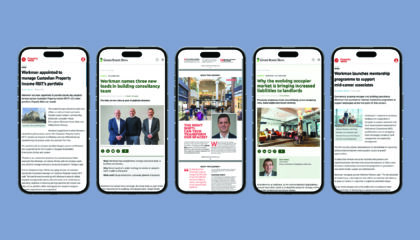From buildings “going rogue” to calculating how much automation can really cut costs in an office, our James Hallworth, Head of Building Technology reflected on our intelligent building operating system, IBOS, now installed across more than 5 million sq. ft of commercial space. Results prove the power of smart tech to immediately improve building performance.
This is particularly pertinent in the context of spiralling energy prices, the climate emergency and hybrid working patterns that have made traditional operating practices deeply inefficient. Clients adopting the technology include Blackrock, Columbia Threadneedle and Federated Hermes. This demonstrates the growing demand for smart building solutions.
Workman partnered with tech specialist Bubll to create its own tool to automate and optimise building operations, dedicating full-time resource to the project. The platform uses Internet of Things (IoT) sensor technology to facilitate the automation of operations, remote engineering capabilities and building data reporting and analytics. This makes it it a prime example of the power of intelligent building solutions.
Since launch, over 4m sq. ft of commercial real estate is now using IBOS as demand for smart building technology soars, primarily to improve energy efficiency as a result of soaring energy costs, and improve the sustainability performance of buildings.
Here are James’s eight insights from optimising 4m sq. ft of commercial space with IBOS roll-outs:
1. The benefits of smart buildings
Our system can discover problems without maintenance workers necessarily having to go to site to investigate.
Building technology, therefore, drives more focused and targeted maintenance. It can prove more profitable for facilities management businesses. This allows them to put their employees where they can make a real difference.
One London office achieved a 15% reduction in energy consumption within three months of implementing IBOS. This resulted in a saving of about £180,000 per year. We identified an out-of-hours energy spike, which we were able to reduce through optimisation rules.
Similarly, optimising out of hours energy use was key to an Uxbridge office cutting energy usage by 28% for an estimated saving of over £500,000 per year.
However, its not just about cutting operating costs and energy management. This technology can also have significant improvements in building performance such as in indoor air qualityand user experience.
2. You don’t need scale for a successful roll-out
The smallest space we have installed IBOS is 3,600 sq. ft; the biggest is more than 200,000 sq. ft. Both are financially viable, both yield rewards and a swift return on investment. This misconception is often a barrier to considering the technology needed to create intelligent buildings.
3. Technology procurement is an art, not a science
Buy too much and you risk a stock of kit that could date quickly, buy too little and – with challenging lead times in this market – you could run short.
Arguably the best way to mitigate this riddle is to install systems that allow for a level of flexibility in the brands and types of parts that are compatible. That said…
4. Knowledge of the supply chain is critical
The days of placing an order and knowing it will come are gone. Workman has mitigated a lot of risk because we know our supply chain, we can pre-empt issues by considering alternative providers or by guiding a client to factor lead times in.
5. World events have shifted landlord needs
Technological monitoring of usage was a nice-to-have when we began our IBOS journey: a way of getting ahead of the curve in ESG terms.
In today’s market, it’s a vital must-have. The shift now encompasses net zero efforts as well as energy price mitigation, with concerns over energy pricing volatility leading to even greater roll-out.
Building owners must demonstrate tangible savings and the payback period is more rapid because of the sheer cost of energy supply, so retrofitting smart building systems makes more commercial sense than ever.
6. It’s extraordinary how many buildings go rogue out of hours
Most of the quick and significant savings we have made are around what happens in a building when its occupants aren’t using it. Without software like IBOS’s 24/7 monitoring and data analytics, it’s easy to miss out-of-hours opportunities to save.
Building Management System (BMS) maintenance is traditionally installed assuming a check-up process occurs: a controls piece rather than efficiency piece. We designed IBOS to be both.
7. Building tech cannot be a part-time consideration – even if you’re working with a tech partner
Workman committed to IBOS as a major opportunity area – invested in it and made it a proper service line with standalone resource. The nature of installing and refining smart building solutions is that you can’t dip a toe in and see how it goes.
To make real impact you need to dive in and challenge how things are done.
8. Know your limits
Combining the thinking of those working in the built environment with tech professionals paves the way for additional innovation – new opportunities, new ways of capturing data, new areas on which to focus. The beauty of building tech is that it is not static – it can always be added to and enhanced.
You would never think twice about consulting a lawyer on a libel consideration or a plumber about improving drainage. Building technology software is no different and the combination of skills Bubll and Workman bring to the table are a big part in making IBOS deliver.



